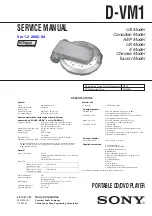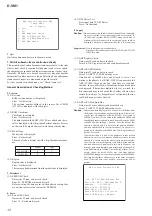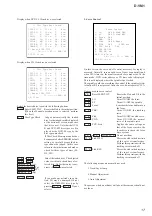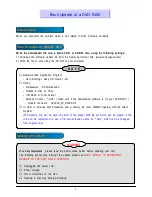
2
D-VM1
Flexible Circuit Board Repairing
• Keep the temperature of the soldering iron around 270 ˚C dur-
ing repairing.
• Do not touch the soldering iron on the same conductor of the
circuit board (within 3 times).
• Be careful not to apply force on the conductor when soldering
or unsoldering.
Notes on chip component replacement
• Never reuse a disconnected chip component.
• Notice that the minus side of a tantalum capacitor may be dam-
aged by heat.
Unleaded solder
Boards requiring use of unleaded solder are printed with the lead-
free mark (LF) indicating the solder contains no lead.
(Caution: Some printed circuit boards may not come printed with
the lead free mark due to their particular size.)
: LEAD FREE MARK
Unleaded solder has the following characteristics.
• Unleaded solder melts at a temperature about 40°C higher than
ordinary solder.
Ordinary soldering irons can be used but the iron tip has to be
applied to the solder joint for a slightly longer time.
Soldering irons using a temperature regulator should be set to
about 350°C.
Caution: The printed pattern (copper foil) may peel away if the
heated tip is applied for too long, so be careful!
• Strong viscosity
Unleaded solder is more viscous (sticky, less prone to flow) than
ordinary solder so use caution not to let solder bridges occur such
as on IC pins, etc.
• Usable with ordinary solder
It is best to use only unleaded solder but unleaded solder may
also be added to ordinary solder.
This appliance is classified as a CLASS 1 LASER product.
The CLASS 1 LASER PRODUCT MARKING is located on
the rear exterior.
CAUTION
Use of controls or adjustments or performance of procedures
other than those specified herein may result in hazardous
radiation exposure.
TABLE OF CONTENTS
1. SERVICING NOTE
·························································· 4
2. GENERAL
·········································································· 5
3. DISASSEMBLY
································································ 7
4. TEST MODE
··································································· 11
5. DIAGRAMS
······································································ 21
5-1. Block Diagram – RF/SERVO Section – ····················· 22
– A/V, SYSCON Section – ·········································· 23
– AUDIO Section – ····················································· 24
– VIDEO OUT Section – ············································ 25
– POWER Section – ···················································· 26
– TFT Section – ··························································· 27
5-2. Printed Wiring Board
– MAIN Section (Side A) (Over All View) – ·············· 28
5-3. Printed Wiring Board – MAIN Section (Side A) (1/4) – ········· 29
5-4. Printed Wiring Board – MAIN Section (Side A) (2/4) – ········· 30
5-5. Printed Wiring Board – MAIN Section (Side A) (3/4) – ········· 31
5-6. Printed Wiring Board – MAIN Section (Side A) (4/4) – ········· 32
5-7. Printed Wiring Board
– MAIN Section (Side B) (Over All View) – ·············· 33
5-8. Printed Wiring Board – MAIN Section (Side B) (1/4) – ········· 34
5-9. Printed Wiring Board – MAIN Section (Side B) (2/4) – ········· 35
5-10. Printed Wiring Board – MAIN Section (Side B) (3/4) – ········· 36
5-11. Printed Wiring Board – MAIN Section (Side B) (4/4) – ········· 37
5-12. Schematic Diagram – MAIN Section (1/11) – ·········· 38
5-13. Schematic Diagram – MAIN Section (2/11) – ·········· 39
5-14. Schematic Diagram – MAIN Section (3/11) – ·········· 40
5-15. Schematic Diagram – MAIN Section (4/11) – ·········· 41
5-16. Schematic Diagram – MAIN Section (5/11) – ·········· 42
5-17. Schematic Diagram – MAIN Section (6/11) – ·········· 43
5-18. Schematic Diagram – MAIN Section (7/11) – ·········· 44
5-19. Schematic Diagram – MAIN Section (8/11) – ·········· 45
5-20. Schematic Diagram – MAIN Section (9/11) – ·········· 46
5-21. Schematic Diagram – MAIN Section (10/11) – ········ 47
5-22. Schematic Diagram – MAIN Section (11/11) – ········ 48
5-23. Printed Wiring Board – TFT Section (Side A) – ········ 49
5-24. Printed Wiring Board – TFT Section (Side B) – ········ 50
5-25. Schematic Diagram – TFT Section (1/3) – ················ 51
5-26. Schematic Diagram – TFT Section (2/3) – ················ 52
5-27. Schematic Diagram – TFT Section (3/3) – ················ 53
5-28. IC Block Diagrams ····················································· 54
5-29. IC Pin Function Descriptions ······································ 59
6. EXPLODED VIEWS
······················································ 63
7. ELECTRICAL PARTS LIST
······································· 66
SAFETY-RELATED COMPONENT WARNING!!
COMPONENTS IDENTIFIED BY MARK
0
OR DOTTED LINE WITH
MARK
0
ON THE SCHEMATIC DIAGRAMS AND IN THE PARTS
LIST ARE CRITICAL TO SAFE OPERATION. REPLACE THESE
COMPONENTS WITH SONY PARTS WHOSE PART NUMBERS
APPEAR AS SHOWN IN THIS MANUAL OR IN SUPPLEMENTS
PUBLISHED BY SONY.
ATTENTION AU COMPOSANT AYANT RAPPORT
À LA SÉCURITÉ!
LES COMPOSANTS IDENTIFÉS PAR UNE MARQUE
0
SUR LES
DIAGRAMMES SCHÉMATIQUES ET LA LISTE DES PIÈCES SONT
CRITIQUES POUR LA SÉCURITÉ DE FONCTIONNEMENT. NE
REMPLACER CES COMPOSANTS QUE PAR DES PIÈSES SONY
DONT LES NUMÉROS SONT DONNÉS DANS CE MANUEL OU
DANS LES SUPPÉMENTS PUBLIÉS PAR SONY.



































